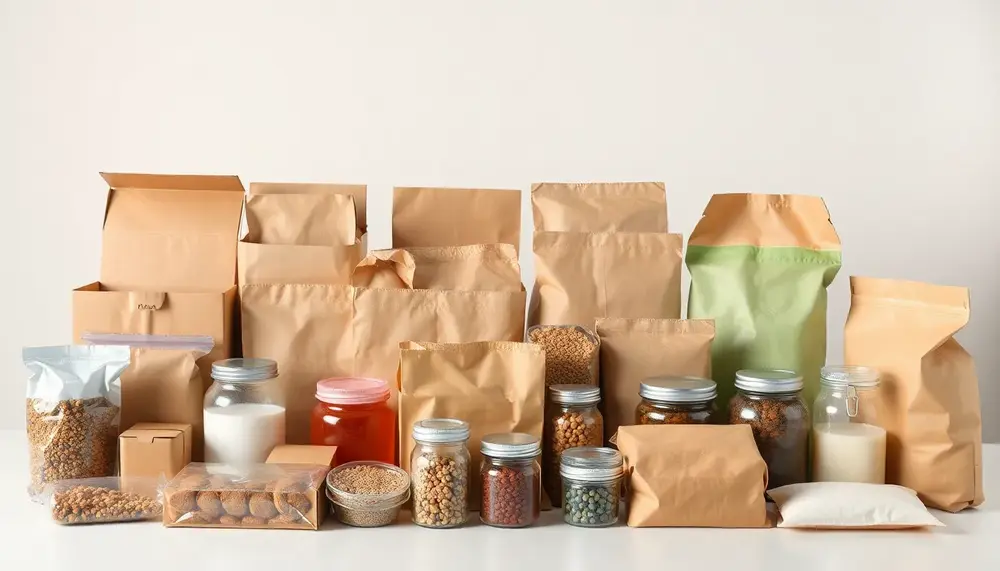Table of Contents:
Definition of "Packaging" in Urdu: Core Meaning and Usage
Packaging in Urdu is expressed as پیکنگ, pronounced as "Packing." While this may look deceptively similar to the English term, its meaning in Urdu carries subtle nuances shaped by local usage and cultural context. In core terms, پیکنگ refers both to the physical materials used for wrapping or enclosing items and to the process of preparing goods for storage, transport, or sale. The word functions as a noun and is commonly encountered in business, retail, and everyday conversation across Pakistan and Urdu-speaking communities.
In daily Urdu, "Packaging" is not just about boxes or wrapping paper; it often implies the overall presentation and protection of a product. For example, when discussing food items, پیکنگ might highlight the hygienic or attractive qualities of the packaging, not merely its functional role. The term is also frequently used in logistics and export industries, where precise and secure packaging is critical for product safety and compliance with regulations.
It’s worth noting that in Urdu, "Packaging" can be context-dependent. Sometimes, it leans more toward the material aspect (like cartons, wrappers, or containers), while in other cases, it refers to the act of packing itself. This dual usage makes the term versatile, but also requires attention to context for accurate understanding and translation.
Urdu Script, Romanization, and Pronunciation Guide for "Packaging"
The word "Packaging" in Urdu is written as پیکنگ. This script is read from right to left, as is standard in Urdu writing. For those unfamiliar with the Urdu alphabet, seeing the word in Romanized form can be a lifesaver—especially if you’re just starting out or dealing with digital communication where Urdu script isn’t always available.
- Urdu Script: پیکنگ
- Romanization: Packing
- Phonetic Pronunciation: [pak-uh-jing]
When spoken, the initial "pa" is short and crisp, followed by a soft "k," and the ending "ing" mirrors the English pronunciation. Urdu speakers may slightly soften the "g" at the end, but the word remains easily recognizable. If you’re practicing pronunciation, try saying it slowly at first: "pak-ing," and then speed up as you get comfortable. This approach helps you sound more natural and less robotic—nobody wants to sound like a translation app, right?
Advantages and Disadvantages of Understanding "Packaging" in Urdu
| Pros | Cons |
|---|---|
| Enhances business and professional communication with Urdu speakers by using precise terminology. | Potential confusion due to context-dependent meanings (material vs. process) in Urdu. |
| Facilitates clearer customer interactions, especially in retail, logistics, and food delivery sectors. | Regional pronunciation and usage variations may cause misunderstandings for non-native speakers. |
| Enables participation in social and cultural conversations (e.g., complimenting gift or food packaging). | Limited access to resources or practice can hinder accurate pronunciation and usage. |
| Aids in compliance with official and regulatory standards by understanding packaging vocabulary in formal documents. | Mistaking packaging as just material or just process can lead to errors in contracts or instructions. |
| Builds cross-cultural competence, allowing smooth code-switching between English and Urdu contexts. | Overuse or incorrect blending with English terms may sound awkward in highly formal Urdu contexts. |
Detailed Meanings of "Packaging" in Urdu Contexts
In Urdu, the term پیکنگ (Packaging) reveals a layered set of meanings that go beyond the surface. It’s not just a word you’ll hear in warehouses or supermarkets—its use can shift depending on the setting, intent, and even the tone of the conversation.
- Commercial and Industrial Contexts: پیکنگ is often associated with the process of securing goods for transport or sale. Here, it covers everything from protective foam inserts to branded cartons. In export businesses, the word can imply compliance with international standards, such as moisture-proof or tamper-evident packaging.
- Daily Life and Social Settings: In casual conversations, پیکنگ might refer to the way food is wrapped for takeaway, or how gifts are presented at weddings. The term can even be used to compliment someone’s effort in making a package look appealing or festive.
- Metaphorical Usage: Sometimes, Urdu speakers use پیکنگ metaphorically. For example, describing a person’s appearance or attire as their "packaging" suggests a focus on outward presentation rather than substance—think of it as the Urdu equivalent of saying, "Don’t judge a book by its cover."
- Legal and Regulatory Contexts: In official documents or government regulations, پیکنگ may denote the specific requirements for labeling, sealing, or material safety. This is particularly relevant in the pharmaceutical and food industries, where packaging must meet strict health and safety codes.
So, whether you’re talking about export logistics, a box of sweets, or even someone’s style, the meaning of "Packaging" in Urdu flexes to fit the moment. That’s the beauty of language—it adapts, and so should your understanding of it.
Practical Examples: How "Packaging" Is Used in Urdu
Seeing "Packaging" in action within Urdu sentences can really help you grasp its real-world flavor. Here are some practical examples, straight from everyday life and business, that showcase how پیکنگ is woven into conversation and writing:
- Retail Scenario: Is ki packaging bohat achi hai. (Its packaging is very good.) This is a common compliment for a product’s look and protection in stores.
- Food Delivery: Kya aap packaging charge alag se lete hain? (Do you charge separately for packaging?) Here, the word refers to the material and process of wrapping food for takeaway.
- Export Documentation: Packaging standard international hona chahiye. (The packaging standard should be international.) This phrase pops up in export or shipping discussions, emphasizing compliance.
- Gift Giving: Gift ki packaging dekh kar hi sab khush ho gaye. (Everyone was happy just seeing the gift’s packaging.) In this context, packaging highlights the decorative and emotional impact.
- Pharmaceuticals: Dawa ki packaging par expiry date likhi hoti hai. (The expiry date is written on the medicine’s packaging.) This points to packaging as a carrier of important information.
These examples show how "Packaging" in Urdu isn’t just about boxes or bags—it’s a word that travels from business meetings to family gatherings, adapting its meaning to fit the moment.
Common English Synonyms of "Packaging"
When translating or discussing "Packaging" in English, a range of synonyms can be useful depending on the specific context. Each synonym carries its own nuance, making it valuable for precise communication in business, logistics, or everyday conversation.
- Case – Often used for containers or boxes, especially in shipping or storage.
- Crate – Refers to a large, sturdy box, typically wooden, used for transporting heavy or fragile items.
- Wrap – Highlights the act of covering or enclosing something, usually with paper, plastic, or fabric.
- Encase – Implies surrounding or enclosing an object completely, often for protection.
- Pack – Can mean both the act of putting items together and the materials used to do so.
- Confine – Less common, but sometimes used to describe restricting or containing items within a package.
- Package – A close synonym, frequently used interchangeably with "Packaging," especially for ready-to-sell goods.
Choosing the right synonym depends on what you want to emphasize: the container, the process, or the protection involved. Being aware of these options can make your translations and explanations more accurate and nuanced.
Understanding the Difference: Packaging as Material vs. Process in Urdu
Distinguishing between "Packaging" as material and as a process in Urdu is crucial for clear communication, especially in professional or technical settings. The same Urdu term, پیکنگ, covers both meanings, but context and sentence structure provide the clues you need to interpret it correctly.
- Material: When "Packaging" refers to the physical items used for wrapping or enclosing goods, it points to things like boxes, plastic wraps, bottles, or bags. In Urdu, this sense is often clarified by mentioning the type of material or by using descriptive words. For example, a supplier might say, nayi packaging material ki zarurat hai (new packaging material is needed), making it clear that the focus is on the tangible objects.
- Process: In contrast, when "Packaging" is about the action of preparing, wrapping, or securing items, it refers to the workflow or method. This usage appears in instructions, job descriptions, or reports. For instance, packaging ka amal mukammal ho gaya hai (the packaging process is complete) highlights the sequence of steps, not the materials themselves.
Understanding this distinction is especially important in business contracts, manufacturing, and logistics, where misinterpretation can lead to errors or delays. Always pay attention to context words or additional phrases in Urdu that clarify whether the speaker means the material or the process.
Tips for Correct Usage and Pronunciation in Urdu
Mastering the correct usage and pronunciation of "Packaging" in Urdu can make your communication smoother and more professional, especially if you’re navigating bilingual settings or formal documents. Here are practical tips to help you sound authentic and avoid common pitfalls:
- Match the Formality: In business or academic writing, use پیکنگ in its full form. For casual speech, shortening or blending with English words is common, but stick to the proper term in official contexts.
- Stress and Intonation: Emphasize the first syllable—pak—and keep the ending soft. Avoid over-enunciating the "g," as native speakers tend to let it trail off gently.
- Contextual Clarity: Pair پیکنگ with descriptive words when needed, such as khushsoorat (beautiful) or mazboot (strong), to specify what aspect of packaging you mean.
- Listen and Imitate: Tune in to Urdu news, commercials, or business meetings to hear how native speakers use and pronounce the word. Mimicking real-life usage is more effective than memorizing textbook examples.
- Watch for Regional Variations: Pronunciation and emphasis may shift slightly in different Urdu-speaking regions. If you’re unsure, ask a native speaker or consult audio dictionaries for reference.
Applying these tips will help you avoid awkward phrasing and ensure your Urdu sounds both natural and precise when discussing packaging in any context.
Value for Learners: Applying "Packaging" in Real Urdu Communication
For learners aiming to use "Packaging" effectively in real Urdu communication, the true value lies in understanding its social and professional nuances. Applying this term correctly can enhance your credibility in business discussions, help you navigate customer service scenarios, and allow you to participate more fully in everyday conversations.
- Professional Interactions: Using پیکنگ accurately in meetings or written correspondence signals that you grasp industry terminology, which can set you apart in fields like logistics, retail, or manufacturing.
- Customer Engagement: When speaking with clients or customers, referencing پیکنگ can help clarify expectations about product quality, delivery standards, or additional costs, making your communication more transparent and trustworthy.
- Social Situations: In informal settings, discussing پیکنگ can help you connect over shared experiences, such as exchanging opinions about gift presentation or food takeaway, adding authenticity to your interactions.
- Cross-Cultural Communication: Mastery of this term allows you to bridge language gaps when working with bilingual teams or international partners, as you can switch between English and Urdu with confidence and accuracy.
Ultimately, integrating "Packaging" into your Urdu vocabulary is not just about translation—it’s about participating meaningfully in diverse conversations and demonstrating cultural competence in both formal and informal contexts.
FAQ: Understanding Packaging in Urdu – Common Questions Answered
What is the Urdu word for "Packaging" and how is it pronounced?
The Urdu word for "Packaging" is پیکنگ, pronounced as "Packing" ([pak-uh-jing]). The word closely resembles its English counterpart, though the pronunciation is subtly localized.
What does "Packaging" mean in the Urdu language?
In Urdu, "Packaging" (پیکنگ) can refer to both the materials used for wrapping or enclosing items (like boxes, wrappers, or containers) and the process of preparing goods for storage, transport, or sale. The meaning depends on the context of the conversation or text.
How is "Packaging" used differently in social and business contexts in Urdu?
In business or industrial Urdu, "Packaging" often relates to compliance, protection, and logistics (e.g., export standards). Socially, it may refer to the visual or hygienic presentation of items like gifts or food, sometimes carrying a compliment or metaphorical meaning.
Which English synonyms can be used for "Packaging"?
Common English synonyms for "Packaging" include: Case, Crate, Wrap, Encase, Pack, Confine, and Package. Each synonym has slight differences in meaning depending on whether you refer to materials, containers, or the process itself.
Why is understanding the context important when using "Packaging" in Urdu?
Because the term پیکنگ in Urdu describes both the physical material and the act of packaging, context is crucial to avoid misunderstandings, especially in business, logistics, and translation scenarios.






